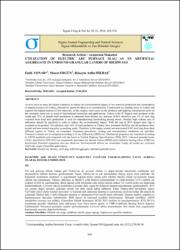Utilization of electric arc furnace slag as an artificial aggregate in unbound granular layers of highways
Künye
Yonar, F., Ergün, M. ve Dikbaş, H. A. (2016). Utilization of electric arc furnace slag as an artificial aggregate in unbound granular layers of highways. Sigma Journal Of Engineering And Natural Sciences-Sigma Mühendislik Ve Fen Bilimleri Dergisi, 34(3), 365-376.Özet
As have been in many developed countries; to reduce the environmental impact of raw material production and consumption of natural resources in Turkey, alternatives should be taken in to consideration. Construction is a leading sector in Turkey and requires the highest amount of raw materials. In this respect, steel sector as the producer and highway construction sector as the consumer stand out, in scope of international researches and applications. Turkey is the 8th biggest steel producer in the world and 75% of annual steel production is obtained from electric arc furnaces (EAF). However just 1% of steel slag occurred from total steel production is used for manufacturing interlocking paving stones. Another high volume area of utilization should be specified in order to reduce the environmental impact. With the end of 2015 treated steel slag is accepted as by-product. Nevertheless only 24% of steel producers in Turkey have treatment facilities and all producers have treated and non-treated slag piles in stocking yards. Therefore in this paper; treated and non-treated EAF steel slag form three different regions in Turkey are examined. Treatment procedures, cooling and contamination conditions are specified. Chemical contents are investigated according to X-ray diffraction (XRD) test. Mechanical properties are examined according to ASTM standards and compared with the limits in Turkish Highway Specifications (THS) 2013. Unbound granular layers (UGL) specified in THS 2013 are compacted; maximum dry density values (MDD) and California bearing ratios (CBR) are determined. Potential expansion rates are observed. Environmental effects are researched. Lastly all results are evaluated within the scope of possible applications.
Kaynak
Sigma Journal Of Engineering And Natural Sciences-Sigma Mühendislik Ve Fen Bilimleri DergisiCilt
34Sayı
3Koleksiyonlar
- Makale Koleksiyonu [22]
- WoS İndeksli Yayınlar Koleksiyonu [6621]


















